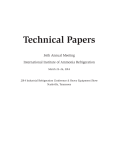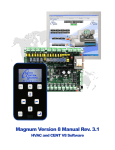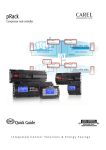Download refrigeration BY DAVE DEMMA
Transcript
refrigeration BY DAVE DEMMA THE GOODS ON OIL FAILURE TRIPS Do you remember that service call you were dispatched to where the frozen food was melting in the display cases? Upon arrival you found the compressor off; apparently for quite some time as its body was stone cold. A quick check of the control circuit with a voltmeter revealed that the oil failure switch was the culprit. After relieving the liquid refrigerant from the crankcase you checked the oil level. It was a little on the low side at 1/4 of a glass, but within the manufacturer’s recommended limits. You carefully restarted the compressor and proceeded to check the net oil pressure. It was measured to be 26 psi; again well within the manufacturer’s specification. Being a thorough technician, you went the extra mile and verified the correct operation of the oil failure control. You found the control’s switch opened 45 seconds after the net oil pressure had fallen below 6.5 psi; perfectly within the specification for the make/model of the compressor. No visible cause was identified. This is a nuisance oil failure trip. How inconvenient. Let’s be clear though. The only nuisance regarding this scenario is that a reason for the oil failure trip cannot be easily determined. To imply that an oil failure trip happens intermittently for no reason implies that oil failure controls have a mind of their own, and periodically decide to shut off a compressor simply to add spice to the technician’s life. Nothing could be further from the truth. Unless an oil failure control is defective, the only time it will trip is when the compressor’s net oil pressure falls below the control’s cut-in point for the specified amount of time necessary for the control to lockout. REAL OIL PRESSURE Understanding component operation always makes troubleshooting system problems easier; but first a brief explanation of the term “net oil pressure” is required. The oil pump inlet is fed 86 HPAC • 80 years MARCH 2006 through a screen located in the compressor sump, so crankcase pressure would be the same as oil pump inlet pressure. The pump takes this oil at crankcase pressure and increases its pressure to some value above crankcase pressure. Unless the crankcase pressure is 0 psi, the oil pump outlet pressure does not tell the complete story. The real oil pressure, or “net oil pressure,” is the difference between pump inlet pressure (crankcase pressure) and pump outlet pressure (discharge pressure). A brief review of how oil failure controls operate is in order. Unlike the typical low, high, or dual pressure control, which has a single switch FIGURE 1 in it, the oil failure control requires two separate circuits to cause a lockout after experiencing low net oil pressure for a predetermined time (see Figure 1). The control circuit switch SC1 is a time delay switch which is wired in series (at terminals L and M) with the other required controls in the holding coil circuit for the compressor motor starter. It is considered the slave in this arrangement, and only opens when acted upon by the time delay heater circuit. In most applications SC1 would be a manual reset switch. However; if a start-stop station were used, an oil failure control with an automatic reset switch could be used. With this configuration an oil failure control trip would cause the start-stop station to open, locking out the compressor starter’s holding coil circuit. While this provides foolproof lockout from low oil pressure, oil failures with this control arrangement are more difficult to troubleshoot. An automatic reset oil failure control that trips the start-stop station when low oil pressure occurs does not leave any evidence that low oil pressure was the problem for compressor lock-out. The time delay heater circuit This circuit requires a 208/240 volt supply to be applied between terminals V1 and 2 (or 120V between terminals V and 2). P1 is a normally closed differential pressure switch which is connected to the compressor crankcase and the oil pump discharge. It measures net oil pressure. P1 opens when the net oil pressure is above the cut-in point for the control, however the cut-in point will vary OIL FAILURE CONTROL depending on the compressor manufacturer’s specification. Some controls allow for adjustment to the cut-in point, and others are preset. H is a resistance heater; the device which trips switch SC1 when CONTINUED ON PAGE 90 BACHARACH Refrigerant Vacuum Pumps 4-Port Refrigerant Manifolds • Two stage rotary vane pump • 1/4” and 3/8” flare and 1/2" ACME intake ports • Light, compact and well balanced • High performance vacuum, HP and CFM ratings for all AC/R applications • One year warranty • 15 micron factory rating • H.D. aluminum block • 3/8” vacuum port fitting • 1/4” flare hose fittings • Protected gauges • H.D. hanging hook • Colour coded easy grip handles for positive control • SHOW & TELL PRESENTED BY NEW PRODUCTS FROM BACHARACH R-410A Manifold (2002-4350) R-22, R-12, R-134A Manifold (2002-4375) QV2 Vacuum Pump 1.7 CFM (2002-0001) QV5 Vacuum Pump 5.5 CFM (2002-0005) www.bacharach-inc.com Circle #46 MARCH 2006 80 years • HPAC 87 PRESENTED BY H O N E Y W E L L G E N E T RO N SHOW & TELL • HONEYWELL GENETRON‚ REFRIGERANTS: THE BEST OPTIONS FOR R-22 REPLACEMENT As R-22 becomes less available due to allocation reductions by Environment Canada as part of the global phaseout of hydrochlorofluorocarbon (HCFC) refrigerants, contractors and equipment owners need suitable replacements. Two hydrofluorocarbon (HFC) refrigerants serve as substitutes for R-22: Genetron® 407C and Genetron® AZ-20® R-410A. While both have proven to have excellent performance, each has distinct characteristics that have led to different uses. R-407C is designed to mimic R-22, and allows for easy conversion of existing R-22 systems to a non-ozone depleting refrigerant. R-407C replaces R-22 in existing air conditioning and mediumtemperature commercial refrigeration systems, including supermarket display cases and reach-in coolers. Converting to R-407C allows manufacturers to use existing production lines, compressors and other R-22 components. In the United States in 2002, several commercial bakeries retrofitted their R-22 refrigeration systems as part of an agreement with the U.S. Environmental Protection Agency, with R-407C seeing the most use in medium-temperature applications without flooded evaporators. In contrast, R-410A represents an advancement in refrigerant technology with several thermophysical properties that improve on R-22 performance. Because of higher design pressures, it is only used in new residential and commercial air conditioning equipment. Various HVAC manufacturers have taken advantage of the superior properties of R-410A, making new systems that are smaller, quieter, and even more reliable than their R-22 versions. While R-410A requires redesigned equipment and tooling due to its higher pressures, it allows for smaller, more economic designs because of pressuredrop and other characteristics. Its near-zero glide also allows for easier recovery and reclamation. while awareness of R-410A as the solution for new residential air conditioners remained flat. To help dealers educate consumers and builders on the transition to R-410A, Honeywell launched www.410A.com, a website that helps educate customers on the R-22 phaseout and their refrigerant choices, and also launched an R-410A advertising and awareness campaign for homebuilders. Globally, R-410A and R-407C have contrasting positions in air conditioning. In North America, R-410A has become the refrigerant of choice for R-22 replacement, and today, most OEMs offer a line of R-410A equipment. R-407C, however, holds a strong position in Europe and Japan where environmental regulations forced the industry to move quickly away from HCFC-22. Because the shift from R-22 was so rapid, compressors and other parts for R-410A were not yet available, forcing the industry to move to R-407C for new air conditioners and retrofitting existing systems. Today, many HVAC manufacturers in Europe and Japan are shifting from R-407C to R-410A because of compact equipment designs and better availability of parts designed for R-410A. But R-407C still finds a range of uses on both sides of the globe, including several types of new equipment made in North America, such as packaged rooftop chillers. R-407C is also found in several types of imported equipment, including mini-split air conditioners, bus and transit air conditioning systems, and specialty chillers used for metal processing and other applications. Honeywell offers a full line of R-22 replacements, including Honeywell Genetron® 407C and Genetron® R-410A in a wide variety of package sizes. For more information on refrigerants and refrigeration topics, visit www.genetron.com. Awareness is Key Despite these successes, awareness of R-410A and R407C and the R-22 phaseout still varies. According to an October 2004 survey of 500 residential homebuilders in North America, awareness of the R-22 phaseout had increased up 10 percent compared to December 2003, Genetron® Refrigerants Exclusive distributor of Genetron refrigerants in Canada Ontario and Western Canada Tel: (416) 243-9615 Fax: (416) 243-9731 Quebec and the Maritime Provinces Tel: (514) 457-3628 Fax: (514) 457-9773 St. Lawrence Chemical Inc. Exclusive distributor of Genetron refrigerants in Canada Ontario and Western Canada, Tel: 416-243-9615 Fax: 416-243-9731 Quebec and the Maritime Provinces, Tel: 514-457-3628 Fax: 514-457-9773 Circle #47 refrigeration CONTINUED FROM PAGE 86 powered for pre-determined amount of time. DR is a simple resistor which allows this circuit to be powered by either 208/240V or 120V. While a jumper installed between 2 and L (or M) can be used to supply one leg of power for the time delay heater circuit (three wire control), it has always seemed more logical to treat these two circuits as two separate circuits (four wire control). Two wires are required to power the time delay heater circuit, and can be taken from to the load side of the compressor motor starter. This circuit can also be powered by a separate voltage source. In either case, the voltage supply to the time delay heater circuit should be wired through a normally open contact in a current sensing relay (sensing motor winding current). This will eliminate power to the time delay heater circuit when the compressor motor is idle. Two separate wires would then be needed to connect L and M to the control circuit. The oil failure control’s sequence of operation is as follows: When the compressor is idle there is no net oil pressure. Therefore, PC1 will be closed. Because the time delay heater circuit receives its power only when the compressor motor starter is energized, SC1 remains closed. SC1 remains closed, providing power to H, until the net oil pressure rises above the cut-in point for the control. If this happens before the required time limit, the heater circuit will lose its power as PC1 opens, allowing the compressor to operate without incident. If the net oil pressure fails to rise above the control cut-in point before the required time limit, the heat generated by H will cause SC1 to open. The compressor will remain off until a technician resets the control. The following are a few scenarios which may explain what appears to be a nuisance oil failure trip. Some compressor motors are equipped with internal winding over- 1 Dunham-Bush Inc • Screw Chillers, Air & Water Cooled Hartford Compressors Inc. • Screw Compressor Packs (Formerly Dunham-Bush) MCS Inc • Micro Controllers, Hanbell Screw Compressors RAE Corp. TSI Division • Reciprocating Chillers Air & Water Cooled Robur Inc • Gas Fired Heat Pumps & Chillers Telephone: 705-835-5100 • Fax: 705-835-5110 email: [email protected] Circle #259 HPAC • 80 years MARCH 2006 PRESENTED BY Colmac Coils Inc • Ammonia Coils & Unit Coolers CONTINUED ON PAGE 92 INNOVATORS IN AIR CONDITIONING, INDUSTRIAL & PROCESS COOLING APPLICATIONS • Serving contractors, industrial end-users, consulting engineers and OEM’s throughout Ontario, our extensive product line includes: • Gas-Fired Absorption Heat Pumps & Chillers • Ammonia Coils & Unit Cooler • Replacement Screw Compressors • Air Handling Units • Fan Coil Units • Microprocessor Controls • Packaged Chillers – Air & Water-Cooled, two tons to 1,100 tons SHOW & TELL “Products for HVAC and Industrial / Process Cooling” D-B COOLING Cooling Systems Inc. 90 loads which open during periods of excessive winding temperatures. This type of overload is in the motor’s internal wiring and it caused by excessive amperage. When an overload of this type occurs, it does not open a switch in the control circuit. The compressor motor starter remains energized during a trip, which means the time delay heater circuit is still receiving power. The oil failure control, being a rather simple device, only knows that the control circuit is energized and that it is sensing no net oil pressure. When the required time passes the control will trip. This scenario really qualifies as a nuisance because it technically is not a low oil pressure problem. As mentioned above, a compressor motor current sensing relay with a normally open switch will eliminate this problem. The switch is wired into the time delay heater circuit wiring. Elimination of motor current D-B president David Bulley who has over 40 years experience in the HVAC/R industry, is an active member of HRAI. "Chillers for the Retrofit Market." PRESENTED BY ARKEMA SHOW & TELL • COMMITTED TO THE FUTURE OF AIR CONDITIONING AND REFRIGERATION Arkema's Forane® 410A and 407C are the contractors best choice for R-22 replacement and retrofit. Meet the next generation with the refrigerants most accepted by OEMs and customers. Nobody knows how to market Forane® 410A and 407C like you and Arkema. That's experience you can't buy from anyone else! The market for Forane® 410A and 407C is huge. There's a world of replacement and retrofitting out there to be done. As always, we're here for you, coming up with ways to keep your customers coming back. Get the performance and after-market support you need. For literature, or to arrange a retrofitting seminar, call 1-800-567-5726 or visit www.arkemagroup.ca A Refreshing Change Stay Cool With Forane®. Arkema’s Forane® 410A and 407C are the contractors best choice for R-22 replacement and retrofit. Meet the next generation with the refrigerants most accepted by OEMs and customers. With Arkema products you get the performance and Visit CMX us at after-market support you need. Booth #2006 1422 1-800-567-5726 • www.arkemagroup.ca Circle #49 MARCH 2006 80 years • HPAC 91 refrigeration CONTINUED FROM PAGE 90 draw when the internal overloads open will cause the current sensing relay switch to also open. This eliminates the power source for the time delay circuit. Refrigeration systems which operate at saturated suction temperatures below 32F require periodic defrost cycles. If the time clock has failed, or if the pins in the clock are worn to the point of not engaging the defrost cycle, the evaporator will ice up. The frost buildup reduces the air flow, which is required to transfer heat to the refrigerant. The resulting loss in evaporator capacity coupled with a thermostatic expansion valve (TEV) sized for full evaporator rated capacity results in a 2 the evidence is gone once again. This potential problem can be eliminated by installing a liquid line solenoid valve, and wiring it in parallel with the fans. When the clerk turns the switch, the fans and solenoid lose power. The system will pump down and the compressor will cycle on its low pressure control. The Btu rating of glass door style FF display cases is determined by a test that requires periodic door openings per hour, and the TEVs are sized accordingly. In this application the TEVs are operating at a high superheat. Because of this the compressor must run longer to ensure proper product temperature. This 4 “When oil failure trips occur, and there does not ‘appear’ to be any evidence to support why, it is the time to put on your detective cap and go to work.” flooding condition. The liquid refrigerant returning to the compressor crankcase will dilute the oil, reducing net oil pressure, and result in the oil failure control tripping. Perhaps the customer shuts off the unit and unloads the display case to prevent product loss. By the time a technician arrives, the ice has melted; and there is no evidence to support why the control would trip resulting in another “nuisance oil failure trip.” A store clerk is loading product into the frozen food walk-in box, which is holding a temperature of -20F. Of course this is a cold place to work in, but the wind chill from the evaporator fans blowing air on him makes it unbearable. Then he notices it – the switch mounted on the wall behind the evaporator. He is hoping it turns the fans off and it does. It is still cold, but tolerable. After loading and arranging the product, taking a much needed 15 minute break, and assisting two demanding customers, over an hour has passed. He turns the fans back on, not realizing that the oil failure control has locked the compressor off. Another loss of oil pressure due to flooding, oil dilution, loss of oil pressure, and 3 92 HPAC • 80 years MARCH 2006 store closes at night, so the doors remained unopened until the following day. The reduced load coupled with the underfeeding TEVs has reduced the refrigerant velocity in the suction riser below what is required for proper oil return. Oil logs in the evaporators, the compressor sump empties, and the oil failure control trips. The technician finds some evidence – an empty crankcase. Unfortunately, the condition has passed. When the compressor is restarted, the ensuing high load condition will bring the oil back to the compressor. REFRIGERATION SCENE INVESTIGATION When oil failure trips occur, and there does not “appear” to be any evidence to support why, it is the time to put on your detective cap and go to work. Make a list, written or mental, of all the possible reasons why the trip may have occurred. It makes sense to eliminate the easy ones first. Realize that the conditions necessary to cause the trip probably won’t be present when you arrive. Investigate, and either confirm/deny the following: ■ Periodic instances of flooding that would lead to oil dilution and loss of pressure. These would include overfeed- ing TEVs, restrictions in the evaporator air flow from dirt or frost, leaking check valves on gas defrost systems, restricted air filters, fan motor/belt issues. ■ Periods of reduced oil return to the compressor crankcase, including low loads, underfeeding TEVs, low head pressure, which reduces TEV capacity, plugged suction filters or other suction restrictions, and piping errors. ■ Compressors use an oil pressure regulating valve to ensure the oil pressure is not too high. Trash lodged in this valve may prevent it from throttling, resulting in a loss of pressure. ■ Worn/defective oil pump. A worn oil pump should make you question the condition of the bearings. Worn bearings/journals prevent oil pressure from building up. Excessive blow by may prevent the check valve between the motor housing and crankcase from opening. Also look for a plugged oil inlet screen. ■ If it is a multi-compressor rack system, a thorough examination of the oil system’s operation is required. There are countless possibilities that could be reviewed, however the point has been made that if a compressor is off due to oil failure control lock out, it is because there has been a low net oil pressure for the required time necessary for the time delay circuit to trip the control. The only exceptions are where the control is defective, or wired in such a way that it can power the time delay circuit when the compressor is not operating. ■ Dave Demma holds a degree in refrigeration engineering and worked as a journeyman refrigeration technician before moving into the manufacturing sector where he regularly trains contractor and engineering groups. He can be reached at 636-239-1111, ext. 242. RATE THE ARTIC LE! Will this information be useful? Please circle the appropriate number on the Reader Postcard. Thank you. . . . . . . . . 109 . . . . . . . . . . . 110 . . . . . . . . 111 VERY USEFUL USEFUL NOT USEFUL PRESENTED BY MADOK SHOW & TELL • CUSTOM HEAT TRANSFER COILS New and Replacement Coils - Copper Tube / Aluminum Plate Fin MADOK’s early growth was based on supplying replacements for heating and cooling coils which had failed due to freezing, corrosion or other causes. While rapid delivery of replacement coils remains an important part of our business, we supply many new coil applications as well. Standard lead time is four weeks - faster delivery is available. The types of heat transfer coils available from Madok include: - Fluid (Cooling & Heating) Coils - Condenser / Heat Reclaim Coils - Evaporator Coils - Standard Steam Coils Corrosion Protection Coatings - Canadian Licensee for Heresite® Protective Coatings Heresite protective coating is a logical extension of our business. Heresite prolongs the life of heating and cooling coils, air/fume handling equipment and other components which must be installed in corrosive atmospheres (including salt water). While Heresite coating can be applied to any of the heat transfer coils fabricated by Madok, the majority of our coating business is applied to other coils and components, including complete units, supplied by customers across Canada. Circle #50 MARCH 2006 80 years • HPAC 93

















